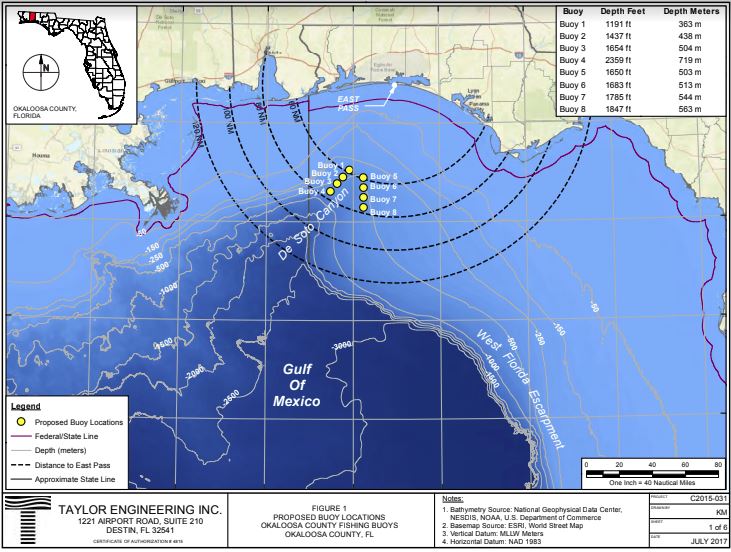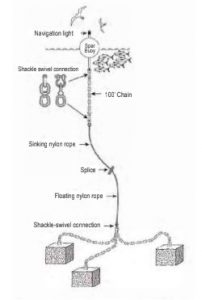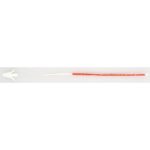
Will Okaloosa County’s (in Florida’s panhandle) planned recreational fishing buoy system perform as a collection of fish aggregation devices (FADs) and draw lots of fish to significantly improve billfish catches like those experienced off Costa Rica? If so, the project might be the beginning of an economic boom for sportfishing eco-tourism in the region. The County also anticipates greater sportfishing activities and possibly increases in billfish and other tournaments in the county.
Project funding includes $500,000 applied for from the Restore Act Fund, created after the Deep Water Horizon settlement. Two applications in that amount have been submitted to two separate Restore Fund grant sources. The county reports it has already spent $136,101 of its funds. One application estimates the project will generate 368 jobs, $56 million in economic impact, $2.6 million in government revenues (fiscal impact) over eight counties. Construction is to begin in 2019.
Among six identified priorities, benefiting the environment is one to which the county provided in its application:
[T]his network will provide environmental benefit, specifically for pelagic species of marine organisms. This network will create habitat where habitat is minimal. This infrastructure will create a diverse ecosystem that will provide ample opportunities to access a pelagic fishery that once was not possible in the region.
“Access to pelagic fishery” is puzzling for a look at previous landings at the former Bay Point Invitational Billfish Tournament in Panama City, Florida reflects large marlin have been landed in the region for decades.
TBF questions to the Army Corps of Engineers, the federal agency charged with review of the project’s huge regulatory compliance areas, included possible impacts on fish stocks if fishing pressure increases. TBF anticipates with a FAD system in the area a transition of fishing pressure from reef fish to pelagic fish, marlin and bluefin tuna, both of which are overfished. The county application addressed this concern as follows:
This project will also transform the region…from a community that targets reef fish species to a community that will access the pelagic fishery. Diversifying the fishing activities in the region will reduce pressure on reef fish species and reduce user conflicts.
While many prefer FAD fishing for it saves time, fuel and usually places their boats where fish abundance is greater; others consider FAD fishing similar to shooting fish in a barrel. FADs do not increase the production of fish, they attract or cause fish to aggregate under the placed floating object after coming from other areas. Management, monitoring and responsible site use, sometimes by rotating among dispersed FADs, is recommended to prevent fishing out local stocks of fish attracted to the FAD.

The buoy design for the Okaloosa project is not yet finalized, but a basic design schematic was included in correspondence to the Corps. The surface buoy indicates it is made of dense foam, with a light, radar reflector and GPS buoy tracker mounted on top and a chain attached to its underside. The chain is connected to a cable or heavy gauge nylon line that falls to the Gulf floor where it is attached to concrete or steel anchors. The county currently specifies no trailing lines, floats or streamers will be attached to the buoys. If such items are attached or placed adjacent to the buoy, a monitoring system should be implemented to determine whether marine life, including sea turtles, mammals, protected species and fish, are being entangled by the trailing or adjacent buoy cover. The size of the buoy/FAD has not been specified.
The Okaloosa project will place buoys in waters inside the DeSoto Canyon, which is within the year-round zone closed to pelagic longline gear in water depths from 1,191 to 2,359 feet. Placement is to be east of what is identified as blue marlin and bluefin tuna spawning and nursery grounds in the Gulf, east of 88 degrees west. (Dr. Jay Rooker, Texas A&M University.) Even so, both species will likely swim through the buoy placement rows and be subject to catch.
Anglers’ favored FADs in the Gulf of Mexico are the large oil rigs, which have been fished for decades.
Become a member of The Billfish Foundation to see more on topics like this and support our work.








